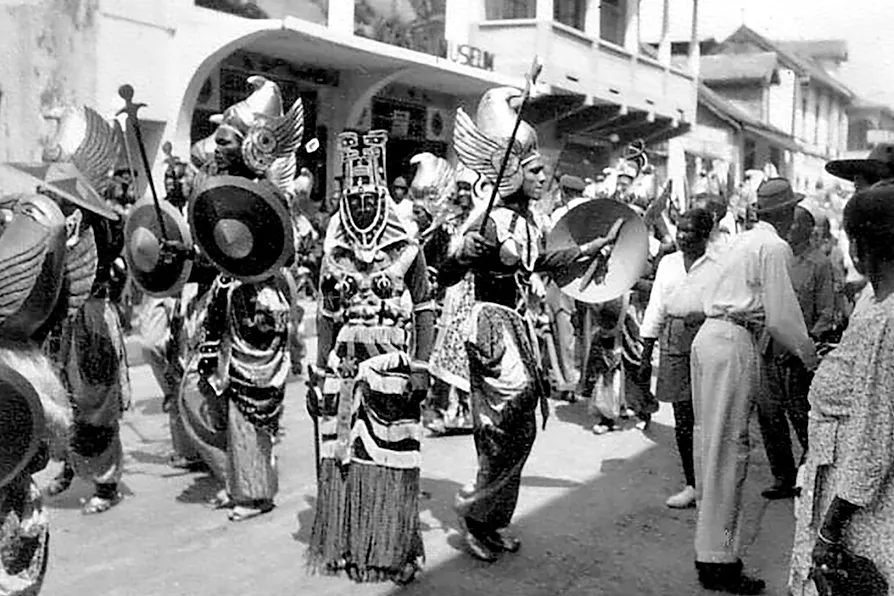Trump’s escalation against Venezuela is about more than oil, it is about regaining control over the ‘natural’ zone of influence of the United States at a moment where its hegemony is slipping, argues VIJAY PRASHAD
DAVID HORSLEY reminds us of the roots and staying power of one of the most iconic festivals around

 IN THE BEGINING: Carnival band photo taken by Dr Ted Hill, in Port of Spain in the early 1950s and made available in public domain by his son John Hill
IN THE BEGINING: Carnival band photo taken by Dr Ted Hill, in Port of Spain in the early 1950s and made available in public domain by his son John Hill
EVERY year the annual Notting Hill Carnival comes under attack, from politicians, the media and especially the growing far right with calls to ban it.
The carnival is blamed for crime, as too expensive to police and as disruptive. In fact from carnival’s beginnings in Trinidad in the 19th century the same reasons for banning it then were rolled out by the same forces locally.
The origins of carnival in Trinidad, which inspired the Notting Hill event, can explain why.
After the enslaved won their freedom in the 1830s, they celebrated openly on the streets regularly every year with music and processions that grew and grew.
Unhappy with this, the authorities tried their best to abolish the celebrations of freedom in different ways.
First they demanded those taking part need special licences, then they tried to prevent the use of drums on the processions. The enslaved had been forbidden the use of drums under slavery so their use was of great significance to the former slaves as an expression not only of their freedom but the connection with the African continent they had been kidnapped from.
The people of Trinidad fought back to keep their new won rights and on many occasions had to defend themselves from the police violence.
In 1884 for example, armed police were brought in to stop the procession, resulting in one death and several injuries. This set a pattern over the years with the authorities striving to end carnival once and for all.
Carnival of course prevailed and in the period after WWII when people from the Caribbean came to settle in what they regarded as the “mother country,” they brought their traditions with them.
The one person most responsible for establishing a Caribbean carnival in London was Trinidad-born Claudia Jones, who arrived here in December 1955. Claudia Jones spent her early childhood in her country of birth but emigrated with her family to Harlem, New York, aged nine.
Years of hardship, suffering both racism and the oppression of the working class as a whole, led the young Jones into the Communist Party of the US (CPUSA), where her natural abilities placed her in a leadership position.
As a leading communist and being foreign born, she was first imprisoned purely for her political beliefs and the deported to Britain.
In London, Jones joined the Communist Party of Great Britain and very quickly, observing the growing racism both from governments and fascists on the streets, she created West Indian Gazette, an anti-colonial, anti-racist newspaper.
In 1958 Oswald Mosley’s fascists provocatively campaigned in the Notting Hill area which had a growing Caribbean community and whipped up a section of local white men to join them in attacks on black people and their homes.
The Caribbean people and white allies defended themselves and Jones seeing the link with black Trinidadians defending carnival from attack, decided to hold the first Caribbean carnival in London.
The idea was for them to celebrate who they were as Caribbean people, their own talents unique culture, music, literature their identity but above all unity.
Jones allied herself with a group of very gifted Caribbean women to create this, Amy Ashwood Garvey, Nadia Cattouse, Pearl Prescod, Pearl Connor and Corrine Skinner Carter.
This first carnival in 1959 was held indoors at St Pancras Town Hall and sections were filmed by the BBC but unfortunately the film no longer exists.
A wealth of Caribbean, African and black British talent including Cleo Laine, Cattoouse, the Southlanders, Edric Connor, the Trinidad All Stars and Hi Fi Steel band alongside a dance troup entertained a large crowd.
This was so successful that two more indoor carnivals took place in 1960 at Seymour Hall and Kensington Town Hall.
The following year a third was held at the Lyceum Ballroom and in 1962 they returned to Seymour Hall and went on tour to the Manchester Free Trade Hall.
In the years that followed with Jones not only spending time in the Soviet Union and China, campaigning and speaking against racism and colonialism and working on West Indian Gazette, there was no time left for organising more carnivals.
Jones died from a heart attack in the early hours of Christmas day 1964, aged just 49. Her short life was dogged by ill health, frequent hospitalisations and aggravated by poor conditions in the US prison system. Despite this, she accomplished so much and part of her heritage is the gift of Caribbean carnival.
Some years after her death, local activists and community workers in the Notting Hill area decided to revive the idea but this time, as in Trinidad, have it on the streets.
So was born the Notting Hill Carnival which despite constant calls for its banning or relocation, survives to this day.
It is not only what Jones instituted, a showcase of Caribbean and African culture and political unity, but one that has attracted vast crowds both British and international and continues to call for solidarity with all those struggling for freedom.
Long may it continue.

White racist rioting has many an infamous precedent in Britain, writes DAVID HORSLEY













